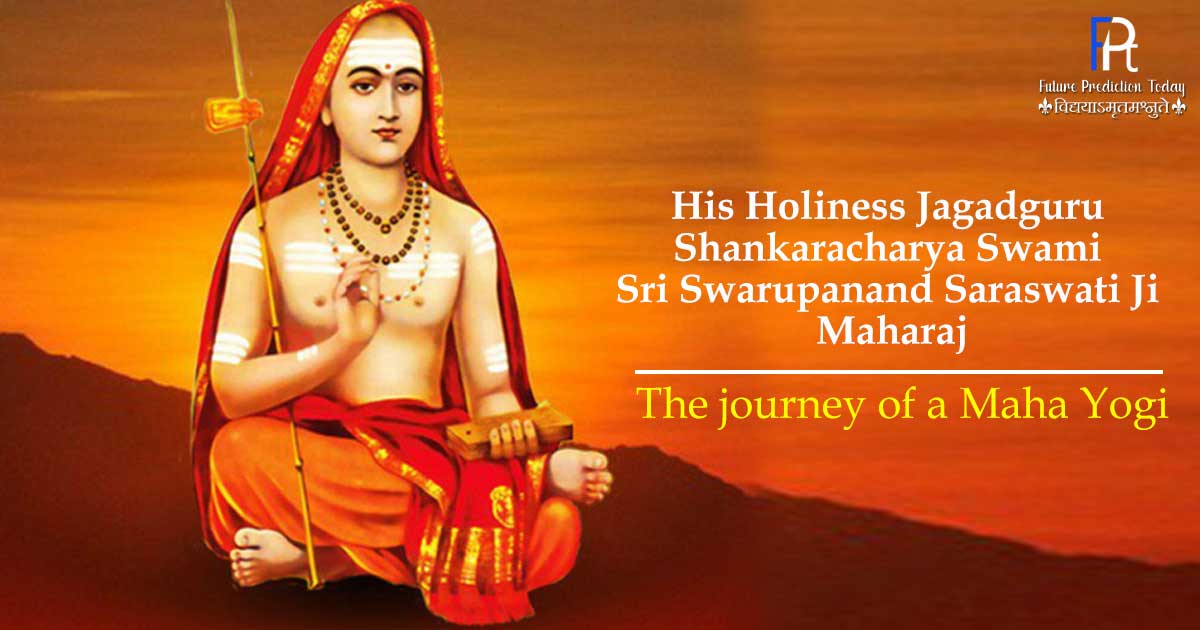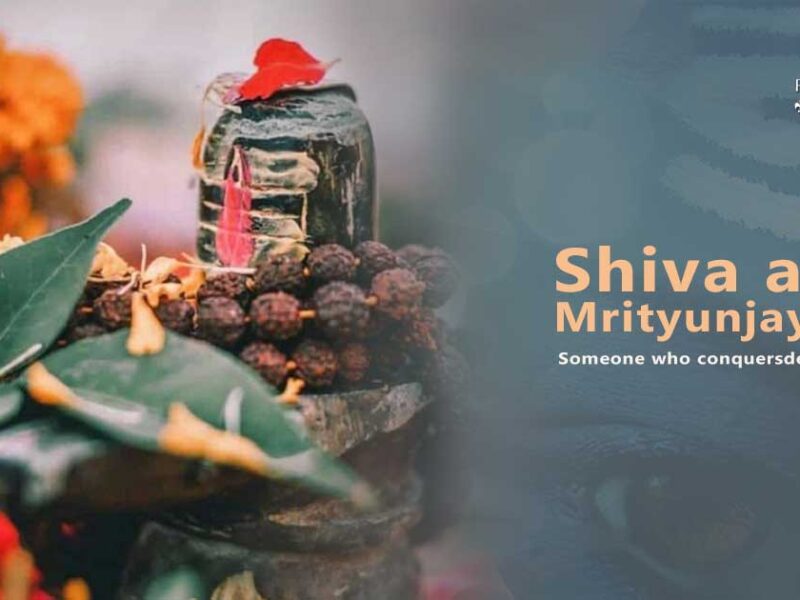1.0.0 Introduction
1.0.1 The Shankaracharya Parampara
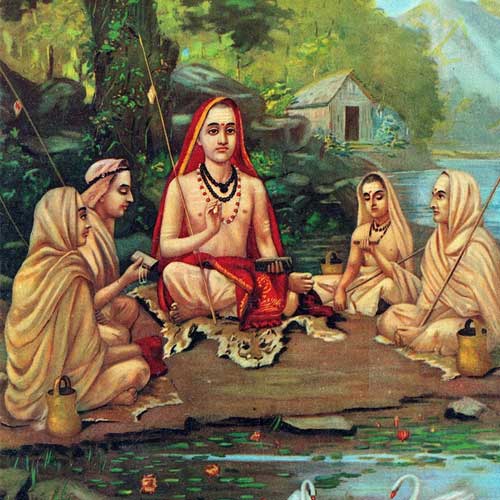
The reason that the Hindu religion is still the most powerful and the most widespread is because of the efforts of Shri Adi Shanakaracharya Ji the founder of the Advaita Vedanta (the school of Hindu philosophy dealing with the Indian traditional techniques to attain cautiousness) and the reincarnation of Lord Shiva himself. He was born in 509BC in Kalady, Kerala. At the age of 8 with the desire to be liberated he left his home in the search of a mentor, walking almost 2000km from Kerala southern India to river Narmada in Central India that’s when he found his “Guru” Shri Govindapada Acharya Ji.
After spending 4 years with his mentor he mastered all the Vedic scriptures under his supervision when he was just 12 years old. After which on his mentor’s suggestion, he began writing transcripts based on his interpretation of the Vedic scripts until the age of 16. From the age of 16 to 32 before disappearing in Bridnath, Uttrakhand he travelled across the length and breadth of India spreading the knowledge and importance of Hindu religion. It must be noted that these were times when the Hindu religion was on the brink of being extinct, and superstitions were more prevelant among people. It was the genius of Shri Adi Shanakaracharya Ji that he restored the greatness of Hindutva through the power of mere dialogue.
The brilliant scholar that he was, he composed 72 devotional and meditative hymns, 18 transcripts on his interpretations of the Vedic scriptures and 12 critical Upanishads ( Sanskrit translations of the religious scriptures based on Hinduism ). He also wrote 23 books on the foundations of Advaita Vedanta which explores the principles of non – dual Brahman (the ultimate reality of the Universe).
1.0.2 The Chatur Dhams
While travelling across India Shri Adi Shankaracharya Ji established four Maths (monasteries) in four different directions in around 700 AD, with the aim of gathering the excellence of all the Sanayasis (monks). He personally selected four of his most senior disciples to be the heads of these spiritual power centres. The significance of these Maths is to maintain prosperity, preserve the main scriptures of Hindu religion (Rig Veda, Yajur Veda, Sama Veda and Atharva Veda) along with the Mahavakyas (the sayings of the Upanishads) and to protect the Dasanami tradition
| DIRECTION | NORTH | SOUTH | EAST | WEST |
| LOCATION | Badrinath | Sringeri | Puri | Dwarka |
| NAME OF THE MATH | Jyotir Math | Sringeri Math | Govardhan Math | Sarada Math |
| SHANAKARACHARYA | Totakacharya | Sureshwaracharya | Padmapadacharya | Hastamalakacharya |
| VEDA | Atharva | Yagur | Rig | Sama |
| MANTRA | Ayamatma Brahma | Aham Brahmasmi | Prajnanam Brahma | Tattvamasi |
| SANYASA DESIGNATION | Giri, Parvata, Sagara | Saraswati, Bharti, Puri | Vanam, Aranya | Tirtha, Ashrama |
Shri Adi Shanakaracharya Ji played a critical role in restructuring the entire system of Sanyasis, by discovering the the Dasanami tradtion.
Giri – one who lives on a hill
Parvata – one who lives on a mountain Sagara – one who lives near the sea Vanam – one who lives in the forest Aranya – one who lives in the jungle Ashrama – one who lives in a hermitage Saraswati – one who is well learned
Tirtha – one who lives near a site with sacred waters
Puri – one who dwells in a town
Bharati – one who is without bondage
2.0 The Life of Guru Ji
2.0.1 The Birth of a Saint
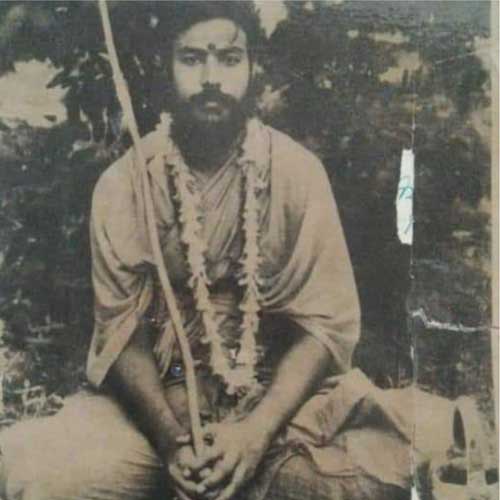
Guru ji was born on 2 September, 1924 in an extremely religious Brahmin family in the village of Dighori, Seoni district located in Madhya Pradesh. His father’s name was Shri Dhanapati Upadhyaya, and his mother’s name was Shrimati Girija Devi while Guru Ji was named Pothirama, “Pothi”means “book”. He had 2 sisters Kusum and Geeta and 4 brothers Ramnath, Ramraksha, Hargovind and Ashivaran. Guru Ji’s birth was predicted by Swami Sivananda Saraswati a very prominent Hindu spiritual teacher and a master of Yoga and Vadanta.
2.0.2 The Search of Knowledge
At the tender of 9 he left home in the search of the truth of life, during his journey he discovered the sacred cave where Shri Adi Shankaracharya Ji received Danda Diksha from his mentor Shri Govindpada Acharya Ji. This cave is in Govind Vanam in Sakal Ghat near Narmada river located in Madhya Pradesh.
At the age of 14 with the desire to gain more knowledge he decided to visit Mugwani, Madhya Pradesh along with his brother Shri Ramraksha Ji. While he was in Mugwani he had an encounter with Shri Swami Muktananda Ji (the pioneer who discovered Siddha yoga defined as the technique of activating the Kundalini or the dormant parts of a human body namely Nadis (energy channels), Chakras (psychic centres), Prana (subtle energy), and Bindu (drops of essence) which when activated by a mentor unleashes unprecedented forces leading to self realisation or cautiousness) during the auspicious time of Chaturmaas, while Swami Ji was in Mugwani he regularly attended every satsangh and speech delivered by Swami Ji for 4 months.
Chaturmas can be defined as the time period during which Lord Vishnu is in a sate of deep meditation. This time period is divided into four months namely Shravan, Bhadrapada, Ashwin and Kartik and begins with Shayani Ekadashi (the eleventh lunar day of the bright fortnight of the Hindu month of Ashadha), while it ends with Prabodhini Ekadashi (the eleventh lunar day in the bright fortnight of the Hindu month of Kartik. This period is ideal to carry out any religious or philanthropic activities.
For the next 5 years Guru Ji studied in a Sanskrit Pathshala in Narsinghpur, Madhya Pradesh and the next 2 years in the Rampur Sanskrit Pathshala under the supervision of Bhola Singh Ji, for whom he became his favourite disciple so much so that Bhola Singh Ji constructed a house for him naming it Mukti Kutir.
2.0.3 The Journey Towards Enlightenment
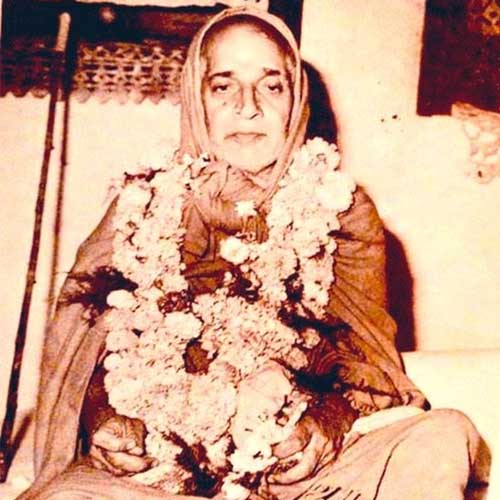
In 1942, Guru Ji met Shri Hariharanand Ojha Ji who later went on to be known as Shri Swami Karapartri Ji Maharaj since, he only use to ate the amount of food which could be accommodated in his palm hence, translated as “Kara” meaning palm and “Patra”meaning bowl. Shri Swami Karapartri Ji Maharaj was the disciple of the then Shankaracharya of Jyothir Math Sri Swami Brahmananda Saraswati Ji and was a teacher in the Advaita Vedanta.
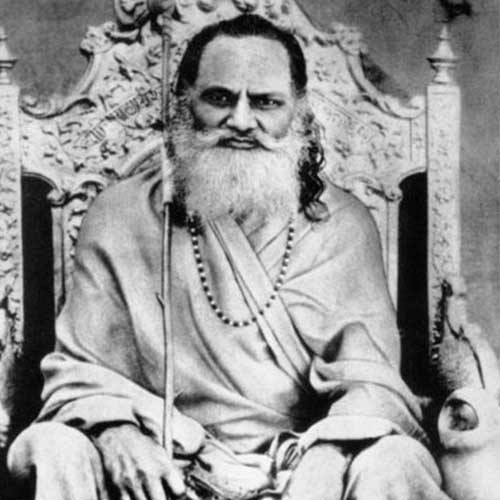
They both witnessed 14 Chaturmaas from 1942 to 1956 at the Karapartri Dham established by Karapartri Ji Maharaj in Varanasi, Uttar Pradesh . It was Karapartri Ji Maharaj who played a pivotal role in Guru Ji obtaining Diksha from Sri Shankaracharya Brahmanand Saraswati Ji on 31st December, 1949 and being declared by him as the Dandi Sanyasi in Calcutta at the Lekhram Kothi and also gave Guru Ji Shri Vidya Diksha.
In wake of the quite India movement when Guru Ji was just 18 years old, he became a very dynamic freedom fighter known to the British as the “Revolutionary Monk”. He served two prison sentences 9 and 6 months respectively for cutting the telephone lines of the British Government.
Guru Ji received the knowledge of Kundalini Yoga from Pritam Das Ji who lived in the Phulwari Ashram in Jhalon Zilla situated in Uttar Pradesh. After which he obtained Siddhi Powers from the Brahma Kund which is situated near Narmada river in close proximity to Sakal Ghat.
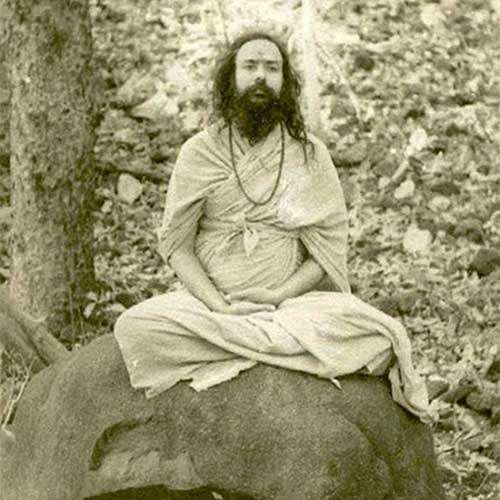
Vichar Shila
In 1943, Guru Ji visited Shridham, Madhya Pradesh and decided to set up a base surrounded by nature. It took him 3 days by foot going through dense jungles in the vicinity of wild animals to reach Paramhamsi Ganga Ashram and that’s where he discovered Vichar Shila, the reason behind this was to find a place where he could perform deep meditation.
He spent the next 12 consecutive years meditating in Vichar Shila and that’s when he gained enlightenment.
2.0.4 The Path Towards Divinity
7th December, 1973 marked the day when Guru Ji was annointed as the Shankaracharya of Jyothirmath at the Shankaracharya Bhavan in Krishna Bodhashram, Kothi No. 7, New Delhi. The Abhishek of Guru Ji was done in the presence of Karpartri Ji, Swami Abhinav Sachdanand Tirth Ji the Shankaracharya of the Dwaraka Shardha Peeth, Swami Nirajandev Tirth Ji the Shankaracarya of the Govardhan Math in Puri, Odisha, the representatives of the Shankaracharya of the Sringeri Sharadha Peeth in the Chikkamagaluru district, Karnataka, Chawla Laxman Shastri a Sanskrit scholar and a Marathi literary critic, Vasant Gargil another Sanskrit scholar and the Central Minister Choudhary Neetraj Singh. 27th May, 1982 marked another very important day when Guru Ji was annointed as the Shanakaracharya of Dawarka Shardha Peeth, it was the only time in the history of the Shankaracharya Parampara that a single Dandi Sanyasi became the Shankaracharya of two seats. This was done in accordance with the will of Shankaracharya Swami Abhinav Sachidanand Tirth Ji which declared that after he leaves his physical body, Guru Ji is to be appointed as his successor as he is well qualified, educated, experienced and the incarnation of Shri Adi Shankaracharya himself. Guru Ji’s Abhishek was attended by Swami Abhinav Vidya Tirth Ji the Shankaracharya of the Sringeri Shardha Peeth, his desciple Bharti Tirth and Swami Bharati Tirth Mahasnnidhanam who would go on to become the current Shanakaracharya of the Sringeri Shardha Peeth
2.0.5 The Protector of Hindu Dharma in Action
Guru Ji as the ambassador of Hindutva has always made sincere and firm efforts in order to protect it and make sure that it reaches to as many people as possible and essentially be adopted as a way of life. It is because of his efforts that the demolition of the Ram Setu bridge was stopped and the 60 year old Ram Mandir dispute was resolved by effortless driving both the Hindu and the Muslim parties towards a peaceful resolution of constructing both a temple and a Mosque on the same land only separated by the Sariyu river.
Guru Ji is also a very successful and enthusiastic philantrophist he says,
“There is a principle about saints which has been mention in the Bhagwat Geeta : “Sarva Bhute Hite Ratah” which means “the individual who dedicates his/her’s life to the service of all the living beings can be called a saint. If we provide treatment to someone who is wounded,
if we heal someone who is suffering from a disease or if we provide education to someone, we
do not do a favour on them or treat it as way of generating wealth it is rather our way of
meditation and spiritual succession.”
Guru Ji provides education to the less privileged Adhivasi children of 50 villages located on the border of Jyoteshwar in Shyamnagar, Madhya Pradesh through his school for higher education called the Sri Shankaracharya Bal Vidya Niketan, which currently facilitates the teaching of more than 1000 students from nursery to 12th grade by well qualified and experienced teachers. This school has 3 scientific labs, a computer lab and a library. This school also organises dancing and various sports events for an all round development of the students studying in it. For university level education Guru Ji oversees the Shri Jagadguru Shankaracharya Mahavidyalaya.
He also established the Shankaracharya Netralaya which is a hospital for people with eye related deceases. This hospital provides the complete check up, treatment and the medication of all the patients completely free of charge. This hospital has successfully carried out 35,000 Cataract operations till date, with 50 patients operated everyday. It also facilitates free lounging and food for all the patients. In order to provide comfort to the estranged elderly he has an old age home as well.
Being a natural visionary he has two extremely ambitious projects in the pipeline firstly, a multi – specialist hospital for the people of Jyoteshwar in order to eliminate their travel time in order to get higher levels of treatment in Jabalpur, Bhopal. Secondly, a university by the name of Shri Shankaracharya University, in order to provide premier education in different fields by the respective specialists in those field.
During the period between 15 – 22 February, 2002 Guru Ji established a unique Sihvling Ji in the Shri Guru Ratneshwar Dham Dighori. This event was attended by all the Shankaracharyas and many influential religious leaders belonging to different religions. This unique Shivling Ji was formed by a rhinestone stone being buried in ice rocks for many years hence, it was bought from Kashmir and it’s worship is considered to be of immense importance in accordance to Hindu scriptures
3.0.0 The Teachings of Guru Ji
3.0.1 Steps to Lead an Ideal Life
“ Janati ichati atha karoti.” Which means “ first comes the awareness of the certain thing, then comes the desire for it and eventually, man performs deeds as per the desire. These three stages are knowledge without knowing the person has no desire and without desire there is no action.”
“ Love, joy, abundance, and happiness can be achieved by following the path of righteousness, Santana Dharma, the eternal law, is about living a fulfilling and more invigorating lifestyle.”
“ That which we depend upon, makes us unhappy, whereas, self – dependency is what brings true happiness. These qualities of happiness and sorrow, in short, are to be understood.”
“ Yah satyamapyavasyakatayam svalpamapi atmano vittaksatim na ksamate sa krpanah” which means “he who hesitates in using his body, life, mind, and intellectual capacity for the realisation of God, is miserable.”
“ The mind is the cause for bondage and liberation” “ Aharasuddhau satvasuddhih
satvasuddhau dhruvasmriti.
smritisuddhau sarvajantunam vipramoksah.”
Which means “ Pure food purifies the mind, the purification of the mind brings about dhruvasmriti (strong memory) and the purification of the smriti (memory) eliminates all complexes.”
“ When pure thoughts pervade the soul through samadhi, the happiness that is attained cannot be expressed through words. It can only be experienced. In reality, as the mind of the man keeps getting purified, his interests too becoming refined. When the interests are refined, the beliefs regarding happiness change.”
3.0.2 Things to Avoid
“Adattanamupadanam himsa caivavidhanatah paradaropasevaca
sariram trividham smrtam parusyaanrtan caiva paisunyancapi sarvasah Asambaddhapralapasca vanamyam syaccaturvidham paradravyesvabhidhyanam manasanista – cintanam vitathabhinivesasca manasam trividham smrtam”
which means “ Forcibly seizing other’s possessions, violence directed towards living creatures and keeping sexual relations with another’s wife are the three physical vices. Speaking harsh words, lying, slandering others and idle chattering are the four verbal vices. Scheming to procure other’s wealth, evil thoughts and stubbornness are the three mental vices. All these add up to ten vices. These ten vices are responsible for a man’s disbelief and lack of faith in God.”

